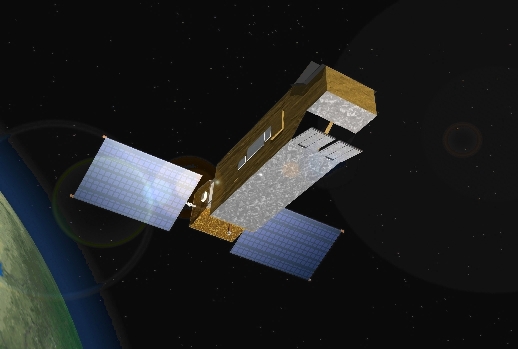

Mission Status Report #66 Star Date: Apr. 22, 2003
New software Load and Test in Progress!Caption: Graphic showing how FUSE would look on-orbit. The telescopes are looking toward the upper right in this picture, and only two of the four telescope doors are visible from this angle. The blue rectangles represent the solar panels, which connect to the spacecraft at the bottom. (Figure courtesy NASA and the FUSE project.)
I am happy to report that operations with FUSE have gone very smoothly since my last report. On April 1, 2003, we officially began the "Extended Mission" phase of the project, and on April 10, 2003, the FUSE satellite completed its 20,000th orbit of the earth! A roll-up of accomplishments for the Prime Mission phase shows that nearly 29 million seconds of science data were obtained on more than 1800 unique objects. That's very impressive for a low-earth orbiting observatory. On another front, the long-awaited revised flight software load to FUSE began on April 16, 2003, and testing is on-going for the next several weeks. You may recall from previous reports that the project felt the need to protect ourselves from potential future failures of gyros onboard the satellite, which help FUSE maintain stable pointing and move from place to place on the sky. The new flight software is very clever, using whatever gyros are present and operating, but gracefully compensating for any missing gyros. Basically, as gyros fail, we will just keep on operating! To accomplish this feat, we are loading new flight software to all three computers on board: the Attitude Control system computer in the spacecraft, the Instrument Data System computer in the science instrument, and the Fine Error Sensor (guide camera) processor. This is somewhat akin to performing a "brain transplant" on FUSE while it is in orbit! (I note this is "elective surgery," since we still have operating gyros at this point. But the gyros are a big enough concern that we needed to take this pre-emptive action.) So far, the software load has gone smoothly, and early testing is on schedule. There has been a hiatus in science data acquisition, but later this week we should be able to get back to some plain vanilla science operations and will ramp up observing capabilities as soon as the testing and data analysis allow. My next report (in about one week) will include a further status report of this activity. Stay tuned!
Reported by: Bill Blair, Chief of Observatory Operations
|
